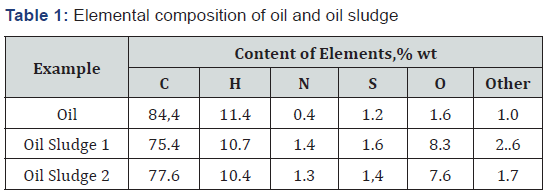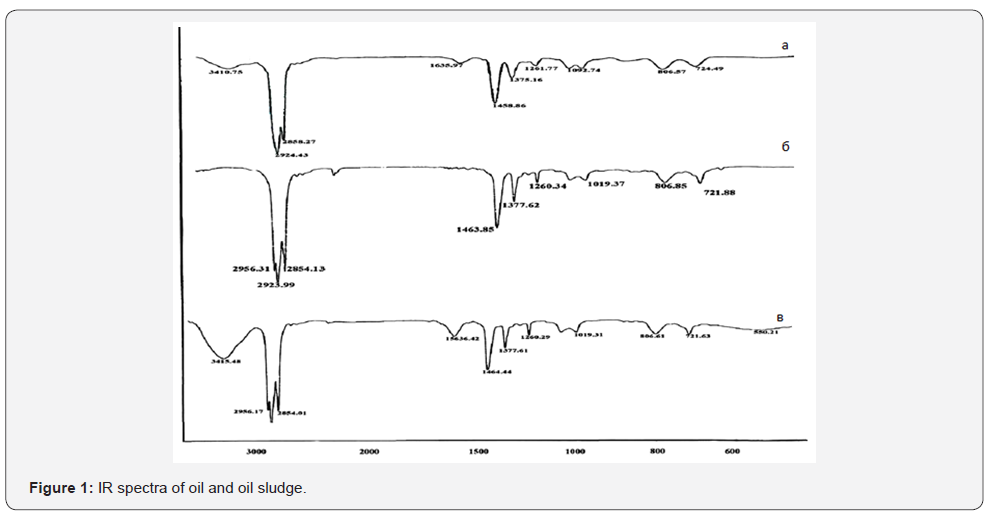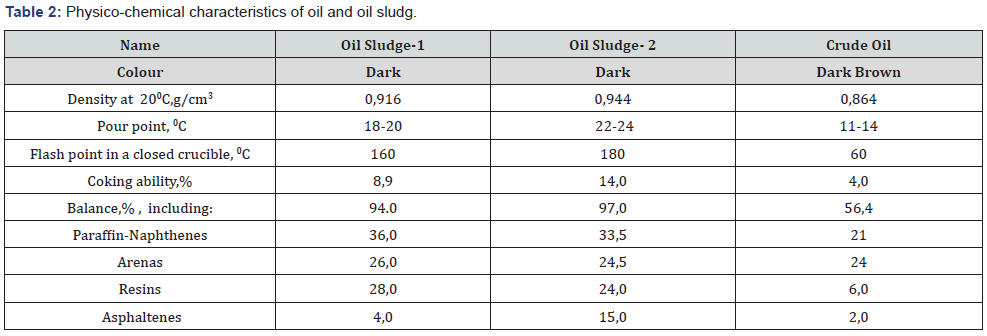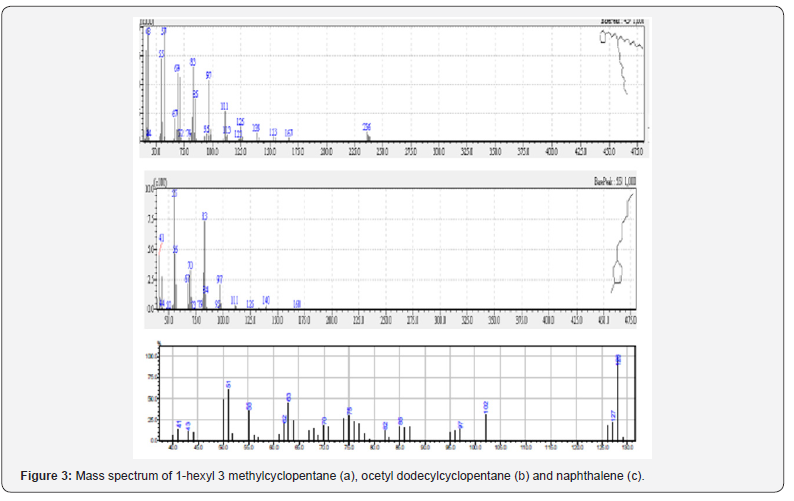Processing Oil Sludge to Produce Petrochemical Products
Jussipbekov U1, Oshakbaev M1, Torebekov O1, Shekeeva K2 and Utelbayev B1*
1Institute of Chemical Sciences named after ABekturov, Kazakhstan
2Central Asian University, Kazakhstan
Submission: September 25, 2018; Published: October 05, 2018
*Corresponding author: Utelbayev B, Institute of Chemical Sciences named after A Bekturov, Almaty, Kazakhstan.
How to cite this article: Jussipbekov U, Oshakbaev M, Torebekov O, Shekeeva K, Utelbayev B. Processing Oil Sludge to Produce Petrochemical Products. Recent Adv Petrochem Sci. 2018; 6(1): 555678. DOI: 10.19080/RAPSCI.2018.06.555678
Abstract
The article considers oil sludge deposits in Kazakhstan for the possibility of obtaining petrochemical synthesis products and petrochemicals. Elemental and hydrocarbon composition were studied. The possibility of their use for the production of petrochemical synthesis and petrochemical products are suggested.
Keywords: Oil sludge; Chemical composition; Fractional composition; petrochemicals
Introduction
The growth rates of oil production and processing of them by the fuel and petrochemical profile require economic and environmental safety of production in the development of technologies [1-2]. Despite the technical safety instructions of the technologies and accidents cause the environmental problems due to oil pollution, and there is a need to improve existing technologies and ensure environmental safety of the environment [3]. Well-known, the content of hydrocarbons and its derivatives in oil waste, emitted by oil refining and petrochemical industries, depends on the composition of the initial oil, the depth of processing of raw materials and the degree of introduction of waste-free technology, the use of equipment and many other factors. Consequently, the release of toxic gases and air pollution depends on the composition of the oil outflows and oil sludge discharged. Oil slimes are also waste products that form the extraction, transportation and processing of oil from which it is possible to extract the target products [4-6]. In connection with the growing problem of environmental protection and the shortage of energy-intensive raw materials, the most promising direction of processing and utilization of oil sludge is the extraction of oil, oil products and solid residues from them, and then using them in the field of petrochemistry. A wide range of physicochemical properties of oil sludge, various conditions of formation and storage cause the use of different technologies for their processing in petrochemical synthesis [7,8]. In the present article, the physicochemical characteristics of oil sludge are studiued for the purpose of using to produce products of petrochemical synthesis.
Experimental Part
Physicochemical characteristics of oil and oil sludge were carried out according to the procedure [9,10]. Element analysis was carried out according to a well-known technique. The density of oil and oil products was determined by the pycnometric method. The values of specific weights and density of organic compounds given in the reference literature are given as ρ420 at the temperature of the highest density of water (+4 °C), when the numerical values of the volume and mass of water are the same. When calculating the density with an accuracy of 0.0001, it is necessary to make a correction for the loss of mass in the air, since when determining the mass of water, the mass of air in the volume of the pycnometer was not taken into account. Then in the calculation we should use the formula:
ρ420 = ρ2020 · (0,9982-0,0012) + 0,0012
where: 0,0012 - density of 1cm3 of air at a pressure of 1 bar; and ai temperature of 20 °C. The coking ability of the oil product is calculated by the formula,%:
X= m/m1 100
where m is the mass of the coke residue, g; m1 - mass of the oil product tested, g.
Analysis of hydrocarbons released up to 250 °C was carried out on GC DANI Master GC (a capillary column made of molten quartz Varian capillary Column CP-PoraPlot Q; 27.5m, 0.32mm, 10μm). The temperature of the evaporator is 300 °C, and the colAbstract umn is 200 °C. Detection-ionization-flame). Fractions 160-320 °С from oil sludge-1 were also analyzed on a chromatomass spectrometer. IR spectra were recorded on an IRS-29 spectrometer (4000-400 cm-1) in tablets of potassium bromide and vaseline oil.
Oil distillation was carried out at the ARN-3 installation in accordance with GOST 11011-85. Hot water (80-90 °С) was used to extract mechanical impurities from the oil sludge (oiled soil). Isolation of asphaltenes was carried out with the help of solvent- n-heptane, paraffins with alcohol.
The accuracy of the measurement results was evaluated according to the standard deviation (δ) [11]. The correction coefficients t(P, n-1), depending on the confidence probability and the number of measurements, were calculated according to [11]. It was calculated from the Δx values. To estimate the experimental data obtained, a confidence probability of 0.95 was used.
Result and Discussion
The determination of the elemental composition of the investigated oil and oil sludge is represented in Table 1. According to the sulfur content, oil belongs to the second class. The elemental composition of oil and oil sludge differ in content of the main elements. In oil sludge, the oxygen content increases from 1.6 to 7.6-8.3% by weight, nitrogen from 0.4 to 1.3-1.4% by weight. The content of carbon in oil sludge as compared with oil decreases from 84.4 to 75.4-77.6% by weight.

The presence of nitrogenous, sulfuric and oxygen-containing organic compounds is indicated by IR spectra of oil sludge (a, c) and oil (b) (Figure 1). It can be seen from Figure 1 that IR spectra of oil and oil sludge have characteristic absorption frequencies of hydrocarbon and functional groups. The frequencies of the absorption bands in the IR spectra of 2920-2950cm-1 and 2800-2910cm-1 to the methyl and methylene groups, respectively. The absorption bands of 2851-2918cm-1 are characteristic of naphthenic hydrocarbons, especially decalin and its derivatives. For aromatic C = Sar structures, 1635cm-1 absorption bands are characteristic, and a set of bands 722 ± 806 cm-1, which are related to CH aromatic groups, is also observed. The absorption bands of 1700-1760cm-1 and 1680-1700cm-1 are characterized by aliphatic and aromatic carboxylic acids.

The frequency of the absorption band is 3410, 3415cm-1, characteristic of OH-groups. The presence in the samples of oil sludge of the absorption band of oxygen-containing groups in comparison with the initial oil, means the interaction of hydrocarbons of oil sludge with oxygen of air. The absorption bands of 3380-3540 cm-1 are characteristic of the associated groups of amino groups complicated with overlapping hydroxyl groups. The absence of amino groups with an absorption frequency of 3380-3540cm-1 in oils and their appearance in oil sludge suggests the probable binding of atmospheric nitrogen with a hydrocarbon hydroxyl at values of 1140-1230cm-1. Some physicochemical characteristics of the oil and oil slime samples under study are given in Table 2. Chromatogram and mass spectra of fractions 160-320 °С from oil sludge -1 are shown in Figure 2.



Mass spectrum of some hydrocarbons are represented in Figure 3. Chromatomass spectroscopic analysis shows that the fractions 160-320 °C mainly consists of paraffin-naphthenic and aromatic hydrocarbons. From Table 2 it follows that the investigated oil sludge can be used in the production of boiler fuel, petroleum bitumen, coke.
Conclusion
On the basis of the constituent components of sludges, it is proposed to use for the production of bitumen, coke and as a boiler fuel. The content of a sufficient amount of paraffin-naphthenic hydrocarbons allows them to be used for the production of petrochemical synthesis products, protein vitamin concentrates and others.
References
- Abrosimov AA (2002) Ecology of processing of hydrocarbon systems: Textbook. In: Dolomatova MY&Telyasheva ETM (Eds.), Chemistry, Russia, p. 608.
- Tonkopiy MS, Ishkulova NP, Anisimova NM, Satbaeva GS (2011) Ecology and sustainable development. Аlmaty: Economy, Russia, p. 378.
- Alinov MSh (2012) Ecology and sustainable development: Textbook. In:Alinov Msh, Almaty, Bastau, Russia, p. 268.
- Dzhusipbekov UZh, Oshakbaev MT, Utelbayev BT (2017) Oil sludge and their utilization. Science and World, Russia, 12 (52).
- Utilization and processing of oil sludge in Kazakhstan kazecosolutions. kz/.../kak-utiliziruyutsya-i-pererabatyvayutsya-nefteshlamy-vkazahst. Russia.
- Nefteshlama.ru - oil sludge and oil waste, processing and ... www. nefteshlamy.ru/ Russia.
- Davydova SL (2007) Resource and ecological features of oil and gas production: textbook. In: SL Davydova, VI Tagasov, MRUDN, Russia, p. 172.
- Zhumurova AK (2006) Petroleum policy of Kazakhstan: formation and development (economic aspects): the dissertation author’s abstract on the scientific competition. StepCandeconomic sciences / AK Zhumurova. - Almaty: Un-t “Turan”, Russian, p. 30.
- Technical analysis of oil and petroleum products. poznayka.org/ s4276t1.html .Russia.
- KirsanovYuG (2016) An analysis of oil and oil products. In: YuG, KirsanovMG, IshiyevAP, Konyaeva. Ekaterinburg: Ural University Publishers, Russian, p. 88.
- The theory of errors and the processing of experimental results. agym. spbu.ru/docs/phys_oshib_4.pdf.Russia.






























